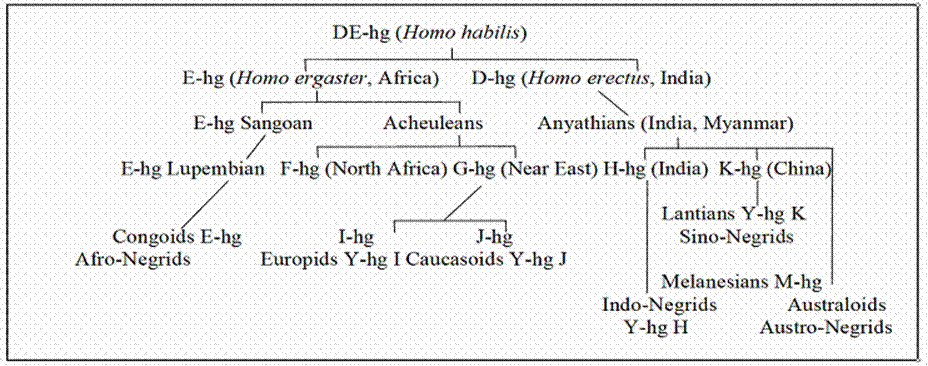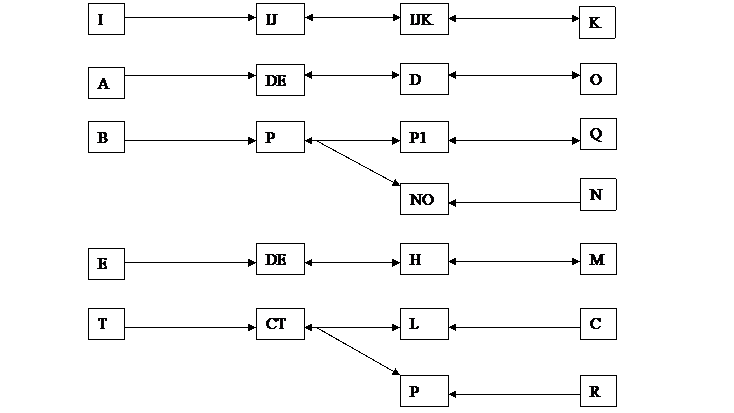|
|
|||||||||||||||
|
|
|||||||||||||||
|
|
|
||||||||||||||
|
|
|
||||||||||||||
|
|
|||||||||||||||
|
|
Y-DNA Haplogroups of Caucasoid Tribes Clickable terms are red on the yellow background |
||||||||||||||
|
Map 1. The Migration Tree of Elamitoid Caucasoids with the Y-DNA Haplogroup J-M304 |
||||
|
|
The Mid-Range Reach of
Chromosomal Genome Typology According to temporal durability,
anthropological parameters may be divided into short-range markers, mid-range
markers and long-range markers. The ABO blood groups belong to the category of
long-range markers because they encroach upon typology shared by
leptorrhinian apes in the Most anthropologists adhere to the Chris
Stinger’s monogenetic single-origin theory that derived the descent of
humankind from African hominids. They support the out-of-Africa model of
anthropogenesis that claims that all living races owe their roots to Homo
sapiens born in eastern Current accounts of population genetics
have summarised the prevailing monogenetic classification that endeavours to
arrange all human chromosomal Y-DNA haplotypes into one evolutionary tree. It
attempts to explain their rise via a series of successive mutations. The
contemporary widely-accepted ordering of Y-DNA genomes is outlined in Table
1. It enjoys an autoritative influence but cannot conceal a few apparent
inconsistencies. It fails to associate the African Negrids with the Oceanic
Melanids and the African Negrillos with the Negrito of South East Asia.
Neither does it associate the Uralids with the haplotype N with the Ugrids,
who share the Y-haplotype Q with Amerindian Algonquin wigwam-dwellers.
To general surprise, it finds closely related kinsmen in the N-haplogroup of
Uralids and the O-haplogroup of the shortsized Sinids, although they speak
incompatible isolating languages.
Table 1. The current
ordering of Y-DNA haplogroups ("ISOGG 2015 Y-DNA Haplogroup Tree Trunk". isogg.org)
Table 2. The Y-DNA
diaspora of Palaeolithic axe-tool makers |
|
A Proposal of a Revised
Taxonomy of Y-Haplogroups The
ethnic interpretation of chromosomal types is governed by inveterate
traditions of comparative linguistics that derived national tongues from the
groupings of ancient and early medieval languages. Almost every local
agglomeration of languages was proclaimed to represent a genetic family on
account of fifty lexical cognates betraying similar etymology. It was termed
‘language family’ or a Sprachbund’, although it usually arose as a
loose conglutination of several independent ancient tribes in the neigbourhood
of a county or petty kingdom. The reconstruction of Old Celtic, Germanic,
Slavonic, Iranic, Dravidian or Austronesian was not carried about from tribal
and dialectal identity but national unity. Members of such groupings were not
genuine kinsmen but only secondary in-laws. They were just neighbours linked
with one another by contact and mutual intermarriages, not by common
ancestors. In their circle the role of common predecessors is automatically
ascribed to the most populous kin or the latest colonists. So they have to be
considered as heterogeneous language domains of several extraneous
substratum ethnicities are subjected to one dominant superstratum. Out-of-Africa exodus
Europids
Pre-Europids Sanids
Sinids Pygmids
Negritos Khoids
Ugrids Maasaids
Scythids Uralids
Sarmatids Negrids
Melanids Congids
Papuasids
Kafrids
Tungids Pelasgids
Palauids
Turcoids
Cimbrids Table The refined substratum approach warns that
all nations, languages, religions, races and genetic groups represent mixed
medleys and have to be analysed into the original pure elements. The lacunous
haplogroup islets may coincide with a definite tribal ethnicity but high
frequencies of their inherent haplogroup are manifested only in relatively
recent plantations. Europe abounds in high frequencies of the Indo-European landmarks
I1 and I2, while the second prominent group is formed by the Y-DNA types R1a
and R1b and mtDNA type U of Turcoid origins. Their occurrence is due to
Mesolithic colonisations of Maglemosians and Magdalenians dated back to 9000
and 17,000 BC. The third populous component was imported by Gravettians (33,000 BP) of Celtic, Gallic
and Slavic descent and the fourth by the Aurignacians (40,000 BP).
Their chromosomal types were peculiar to the Tungusoid Baltids, Ladogans,
Polonids and Polovtsy and may appear in low frequencies of Y-hg C.
Gravettians provably from the Galla region of Probable transitions between three
neighbouring areas of haplogenetic evolution are demonstrated in Table 2. The
earliest lineages set out on an out-of-Africa exodus from the motherland of
most hominids. Soon they arrived in the Near and Middle East, where they
underwent transformations that turned into transitional subtypes and new
formations. Their mutual diffusion created intermediary haplotypes falling
into the transitional ‘out-of-Levant exodus’. In other words, the mainstream
of |
|
|
The
Origin of the Caucasoid Elamitids with the Y-DNA haplogroup J-M304 Our earlier books supported the hypothesis
that the Caucasoid racial variety had arisen at When we emphasise the requirement of
typological unity, we insist on the presupposition that the Caucasoids must
have corresponded to two halves of the Acheulian plant-gathering axe-tool
makers. The first half settled down in Elamitoid Caucasoids split
into the western groups J1-M267 and the
eastern group J2-M172. The former group propagated especially
in the Italids: a convenient denomination that looks like a suitable term for
Spanish and Italian Caucasian Elamitoids with bull worship, bull-fighting, pithos
jar burials and flat-roofed houses. Their distribution and density is highest
in southern Italids with the J2a1b-M67: Italiotes/Italici,
Frentani, Brutti, Elymi/Elymoi (western Epirotids (J2b2-L83): a tentative term for Elamitoid subclades that
settled around Epiros in ancient Albania. Epiros: Paravei, Atintania?, Aperania, Hittids (J1a2-ZS3089): Heteans,
Hetheans, Hittites, Hittim ( Levant: Jews, Judeans, Idumaeans, Edomites, Heteans. Creta: cultic centre on the sacred Godoberids (J1a2b-CTS15/Z1828): a tentative
term for genuine Elamitoid Caucasoids different from Khwarshi. Lengyelians (J2a-M410): the most influential branch of Elamitoids
flooded Susian Elamitids (J2a4h): the Mesopotamian
Elamitids penetrated into central |
|
The
Olympic Cult of Zeus The most astonishing conclusion
concerning the origin of Greek mythology is the hypothesis that Zeus did not
seize the throne in the Olympian pantheon as a patron deputy of Iindo-European
tribes but he was delegated as a heavenly king of oriental Elamitoid peasantry
from (a) the (b) the mountains Olympos and Ida Mons near
Cydonia in (c) Ida Mons in Olympene and Abrettene, (d) (e) (f) (g) the mountain Olympos in Peraea and the
volcano (h) (i) Ancient Greek polytheistic region and its
Olympian pantheon resulted from a long process of Pan-Hellenic convergent
integration uniting isolated regional cults. It is false to imagine that
Neolithic tribes celebrated several hundreds of names in the Olympian
genealogy, they originally worshipped only a couple of deities alluding to
the ethnonyms of their phratries: (1)
Idaeans (from Hades, Ida Mons Gutii, Hatte, Hittim, Aigyptoi,
Aethiopes), (2)
Olympians (from (3)
Persians (from Persephone, (4) Susians (from
Every
tribal confederacy of Greek farmers carved wooden idols of their own chthonic
polytheistic divinities. They erected them in the sacred grove on the slopes
of the cultic mountain The
Homeric term Illion for |
||




